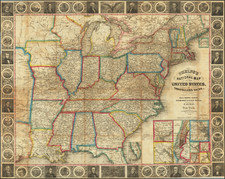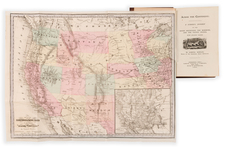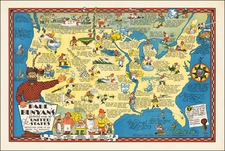Rare map of the British Colonies and neighboring regions, which appeared in a rare geography book by John Cowley.
While the map is small, it is packed full of early information about the British Colonies. The treatment of the Mississippi River and its tributaries is quite interesting. Several early French Forts are shown in the west (Ft. Crevecoeur, Ft. La Salle, Ft. Prudhomme and French Fort in Texas.
Fort Denonville also appears near Niagara Falls. Fort Denonville was a French fort built in 1687 at the current site of Fort Niagara. It replaced Fort Conti which had been built on the site in 1679 and had burned later that year. In the summer of 1687 the Governor of New France, Jacques-René de Brisay de Denonville, Marquis de Denonville, was on a military expedition to pacify the Iroquois. At he end of the campaign season the governor, to keep French presence in the area, moved his army to the site and constructed a post and named it after himself. The fort, which comprised eight wooden buildings and a stockade, was garrisoned by one hundred men and commanded by Captain Pierre de Troyes. The Seneca, in reprisal for Denonville's attack of 1687, laid siege to the fort and denied the garrison the benefits of forage or fresh air. Eighty-nine of the garrison died of scurvy, disease, and starvation during the siege. On Good Friday of 1688 a relief force returned and found twelve survivors. The chaplain of the relief force, Jesuit Father Pierre Millet, erected a cross and gave a mass of thanksgiving for their survival. The fort was re-garrisoned, but in September 1688, the French would pull down the stockade and would not winter there again until 1726 when "The House of Peace" (today known as the French Castle) and Fort Niagara were built on the same site.
A geography textbook title page notes that it was carefully revised and corrected by John Lodge Cowley, Geographer to his Majesty, from a work originally written by the late Mr. Hübner and faithfully translated, with additions and improvements. Johann Hübner (1668-1731) was a German scholar who pioneered the catechetical method of teaching geography, i.e. instruction in the form of questions and answers.











![The Pathfinder Railway Guide Map. Western Section [Alaska, Yellowstone Park / Philippines / Hawaii / Guam]](https://storage.googleapis.com/raremaps/img/small/97894.jpg)
![[ Atlantic Ocean / Triangular Trade / Negroland ]](https://storage.googleapis.com/raremaps/img/small/65187.jpg)
![[ US-Mexico Border Survey: General Order From the President of the United States Directing William H. Emory to lead the US-Mexico Boundary Survey ]](https://storage.googleapis.com/raremaps/img/small/101837.jpg)
